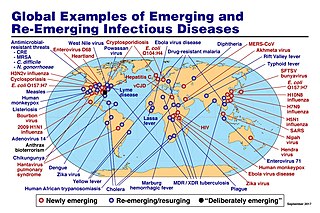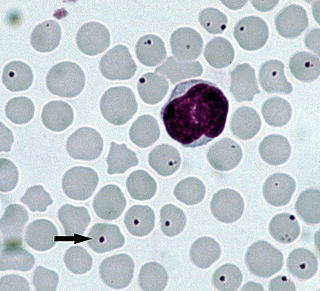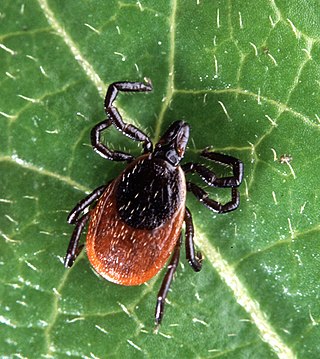Related Research Articles

An infection is the invasion of tissues by pathogens, their multiplication, and the reaction of host tissues to the infectious agent and the toxins they produce. An infectious disease, also known as a transmissible disease or communicable disease, is an illness resulting from an infection.

Carlos Justiniano Ribeiro Chagas, or Carlos Chagas, was a Brazilian sanitary physician, scientist, and microbiologist who worked as a clinician and researcher. Most well known for the discovery of an eponymous protozoal infection called Chagas disease, also called American trypanosomiasis, he also discovered the causative fungi of the pneumocystis pneumonia. He described the two pathogens in 1909, while he was working at the Oswaldo Cruz Institute in Rio de Janeiro, and named the former Trypanosoma cruzi to honour his friend Oswaldo Cruz.
Tick-borne diseases, which afflict humans and other animals, are caused by infectious agents transmitted by tick bites. They are caused by infection with a variety of pathogens, including rickettsia and other types of bacteria, viruses, and protozoa. The economic impact of tick-borne diseases is considered to be substantial in humans, and tick-borne diseases are estimated to affect ~80 % of cattle worldwide. Most of these pathogens require passage through vertebrate hosts as part of their life cycle. Tick-borne infections in humans, farm animals, and companion animals are primarily associated with wildlife animal reservoirs. Many tick-borne infections in humans involve a complex cycle between wildlife animal reservoirs and tick vectors. The survival and transmission of these tick-borne viruses are closely linked to their interactions with tick vectors and host cells. These viruses are classified into different families, including Asfarviridae, Reoviridae, Rhabdoviridae, Orthomyxoviridae, Bunyaviridae, and Flaviviridae.

Carrion's disease is an infectious disease produced by Bartonella bacilliformis infection.

Plasmodium vivax is a protozoal parasite and a human pathogen. This parasite is the most frequent and widely distributed cause of recurring malaria. Although it is less virulent than Plasmodium falciparum, the deadliest of the five human malaria parasites, P. vivax malaria infections can lead to severe disease and death, often due to splenomegaly. P. vivax is carried by the female Anopheles mosquito; the males do not bite.

An emerging infectious disease (EID) is an infectious disease whose incidence has increased recently, and could increase in the near future. The minority that are capable of developing efficient transmission between humans can become major public and global concerns as potential causes of epidemics or pandemics. Their many impacts can be economic and societal, as well as clinical. EIDs have been increasing steadily since at least 1940.

Anaplasma phagocytophilum is a Gram-negative bacterium that is unusual in its tropism to neutrophils. It causes anaplasmosis in sheep and cattle, also known as tick-borne fever and pasture fever, and also causes the zoonotic disease human granulocytic anaplasmosis.

Anaplasmosis is a tick-borne disease affecting ruminants, dogs, and horses, and is caused by Anaplasma bacteria. Anaplasmosis is an infectious but not contagious disease. Anaplasmosis can be transmitted through mechanical and biological vector processes. Anaplasmosis can also be referred to as "yellow bag" or "yellow fever" because the infected animal can develop a jaundiced look. Other signs of infection include weight loss, diarrhea, paleness of the skin, aggressive behavior, and high fever.

Ehrlichiosis is a tick-borne bacterial infection, caused by bacteria of the family Anaplasmataceae, genera Ehrlichia and Anaplasma. These obligate intracellular bacteria infect and kill white blood cells.

Anaplasma is a genus of gram-negative bacteria of the alphaproteobacterial order Rickettsiales, family Anaplasmataceae.

Ehrlichia is a genus of Rickettsiales bacteria that are transmitted to vertebrates by ticks. These bacteria cause the disease ehrlichiosis, which is considered zoonotic, because the main reservoirs for the disease are animals.

Ixodes scapularis is commonly known as the deer tick or black-legged tick, and in some parts of the US as the bear tick. It was also named Ixodes dammini until it was shown to be the same species in 1993. It is a hard-bodied tick found in the eastern and northern Midwest of the United States as well as in southeastern Canada. It is a vector for several diseases of animals, including humans and is known as the deer tick owing to its habit of parasitizing the white-tailed deer. It is also known to parasitize mice, lizards, migratory birds, etc. especially while the tick is in the larval or nymphal stage.
Ehrlichia chaffeensis is an obligate intracellular, Gram-negative species of Rickettsiales bacteria. It is a zoonotic pathogen transmitted to humans by the lone star tick. It is the causative agent of human monocytic ehrlichiosis.

Human granulocytic anaplasmosis (HGA) is a tick-borne, infectious disease caused by Anaplasma phagocytophilum, an obligate intracellular bacterium that is typically transmitted to humans by ticks of the Ixodes ricinus species complex, including Ixodes scapularis and Ixodes pacificus in North America. These ticks also transmit Lyme disease and other tick-borne diseases.

Human monocytotropic ehrlichiosis is a form of ehrlichiosis associated with Ehrlichia chaffeensis. This bacterium is an obligate intracellular pathogen affecting monocytes and macrophages.

Rickettsia parkeri is a gram-negative intracellular bacterium. The organism is found in the Western Hemisphere and is transmitted via the bite of hard ticks of the genus Amblyomma. R. parkeri causes mild spotted fever disease in humans, whose most common signs and symptoms are fever, an eschar at the site of tick attachment, rash, headache, and muscle aches. Doxycycline is the most common drug used to reduce the symptoms associated with disease.
Ewingella americana is a Gram-negative rod, and the only species in the genus Ewingella. It was first identified and characterized in 1983. Ewingella is in the family Yersiniaceae. The organism is rarely reported as a human pathogen, though it has been isolated from a variety of clinical specimens, including wounds, sputum, urine, stool, blood, synovial fluid, conjunctiva, and peritoneal dialysate. The bacterium is named in honor of William H. Ewing, an American biologist who contributed to modern taxonomy.

Transstadial transmission is the persistence of a symbiont or pathogen in an organism from one life stage ("stadium") to the next, such as larva to nymph to adult. This type of transmission is typically observed in insects. For example, the bacterium Borrelia burgdorferi, the causative agent for Lyme disease, infects the tick vector as a larva, with the infection maintained as the tick molts to a nymph and later develops as an adult. Transstadial transmission is also seen with other microbes such as other bacteria, fungi, and viruses in numerous insects. In addition to ticks, mites are another common vector. Transstadial transmission is especially relevant to public health, as several threats to public health are maintained in insect populations by transstadial transmission. Some debate exists regarding the classification of transstadial transmission as vertical transmission versus horizontal transmission. Reasons for this stem from further debate regarding transovarial transmission, described as the passage of a symbiont or pathogen from an infected female to its progeny, especially in eggs.
Anaplasma bovis is gram negative, obligate intracellular organism, which can be found in wild and domestic ruminants, and potentially a wide variety of other species. It is one of the last species of the Family Anaplasmaceae to be formally described. It preferentially infects host monocytes, and is often diagnosed via blood smears, PCR, and ELISA. A. bovis is not currently considered zoonotic, and does not frequently cause serious clinical disease in its host. This organism is transmitted by tick vectors, so tick bite prevention is the mainstay of A. bovis control, although clinical infections can be treated with tetracyclines. This organism has a global distribution, with infections noted in many areas, including Korea, Japan, Europe, Brazil, Africa, and North America.
Neoehrlichia mikurensis (NM), previously known as Candidatus Neoehrlichia mikurensis, is an intracellular, gram-negative bacteria belonging to the family Anaplasmataceae. Using ticks as vectors, it spreads between animals - mainly rodents, but other mammals as well as humans can get infected. After Borrelia and Rickettsia, it is believed to be the third most common tick-borne pathogen able to infect humans. Between 2009 and 2019, 45 human cases of NM-infections were found in Sweden.
References
- ↑ Duron, Olivier; Koual, Rachid; Musset, Lise; Buysse, Marie; Lambert, Yann; Jaulhac, Benoît; Blanchet, Denis; Alsibai, Kinan Drak; Lazrek, Yassamine; Epelboin, Loïc; Deshuillers, Pierre; Michaud, Céline; Douine, Maylis (2022). "Novel Chronic Anaplasmosis in Splenectomized Patient, Amazon Rainforest". Emerging Infectious Diseases. 28 (8): 1673–1676. doi:10.3201/eid2808.212425. ISSN 1080-6040. PMC 9328922 . PMID 35876693.
{{cite journal}}: CS1 maint: PMC format (link) - ↑ André, Marcos Rogério; Calchi, Ana Cláudia; Furquim, Maria Eduarda Chiaradia; de Andrade, Isabela; Arantes, Paulo Vitor Cadina; de Melo Lopes, Lara Cristina; Demarchi, Iuri Kauan Lins do Nascimento; Figueiredo, Mayra Araguaia Pereira; de Paula Lima, Cirilo Antonio; Machado, Rosangela Zacarias (2022). "Molecular Detection of Tick-Borne Agents in Cats from Southeastern and Northern Brazil". Pathogens. 11 (1): 106. doi:10.3390/pathogens11010106. ISSN 2076-0817. PMC 8781600 . PMID 35056054.
{{cite journal}}: CS1 maint: PMC format (link) CS1 maint: unflagged free DOI (link) - ↑ Bakken, Johan S.; Dumler, J. Stephen (2015). "Human Granulocytic Anaplasmosis". Infectious Disease Clinics of North America. 29 (2): 341–355. doi:10.1016/j.idc.2015.02.007. PMC 4441757 . PMID 25999228.
{{cite journal}}: CS1 maint: PMC format (link)